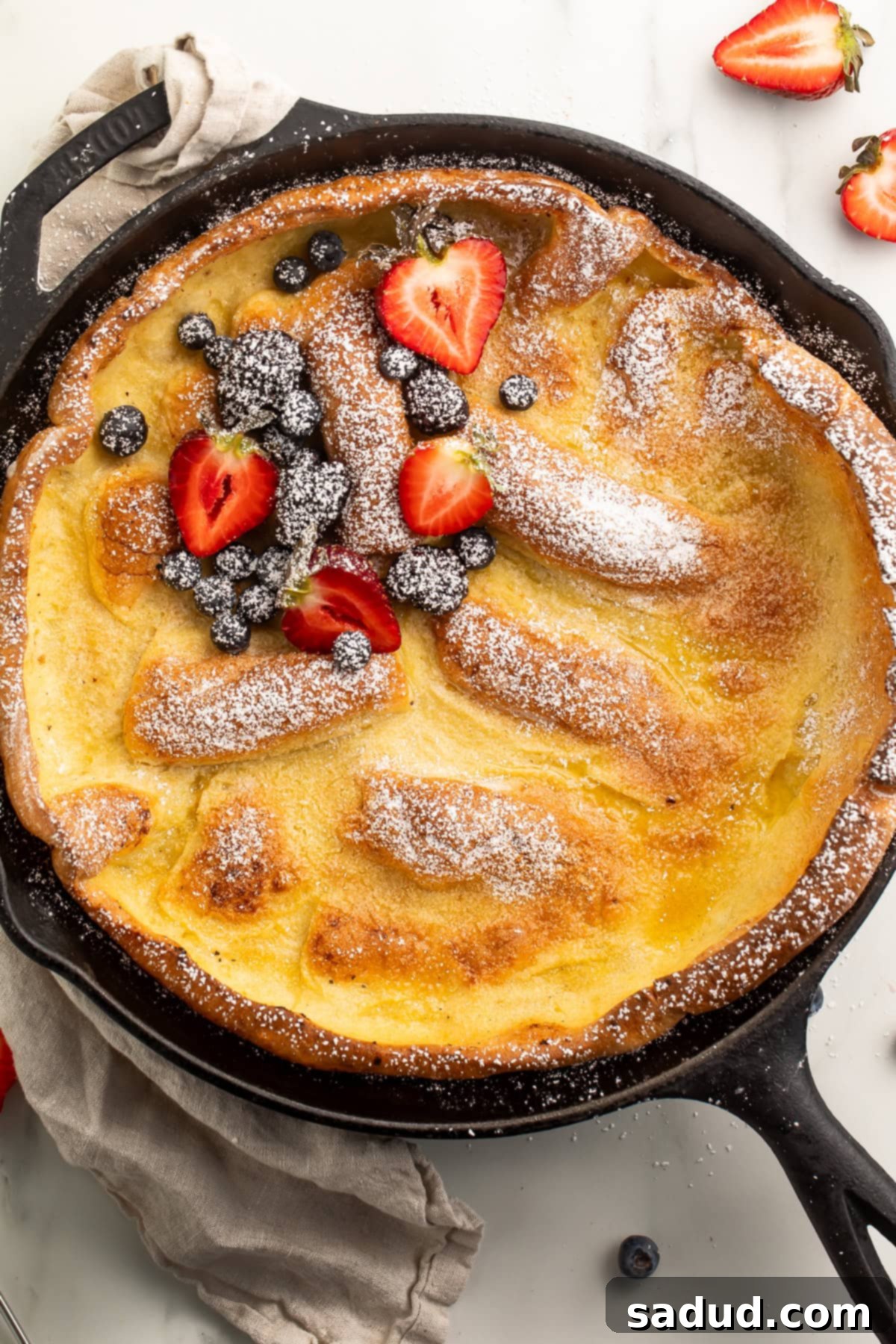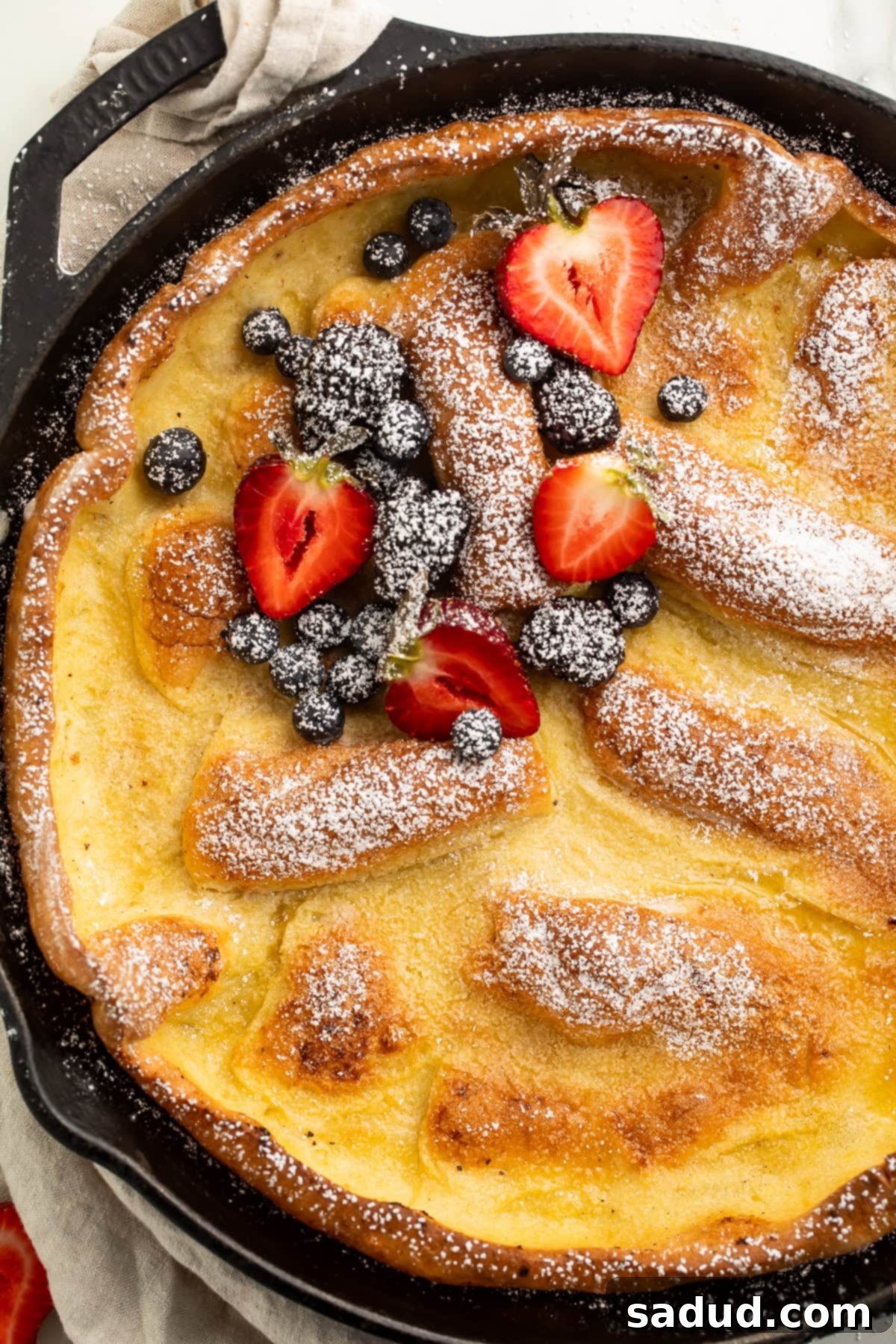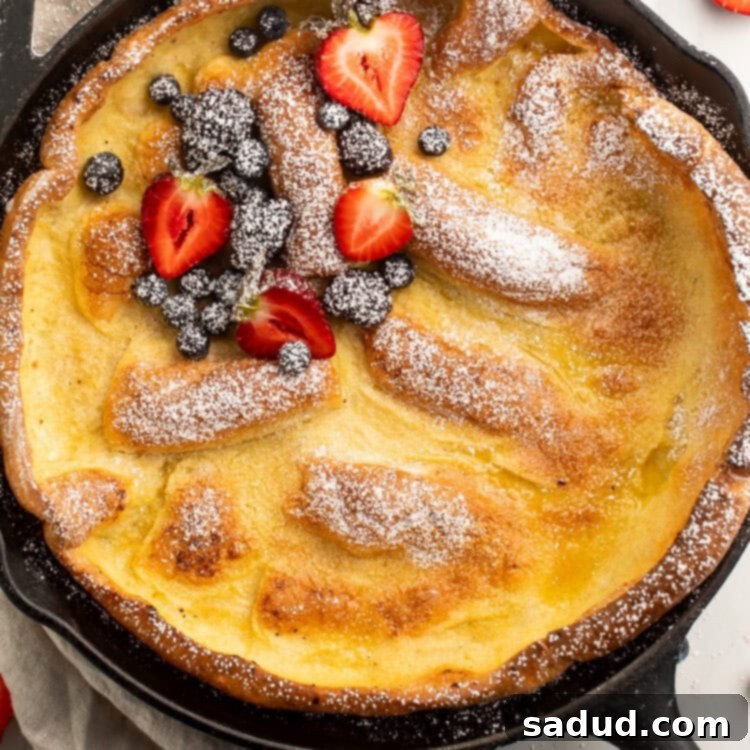The Ultimate Guide to a Perfectly Puffy Gluten-Free Dutch Baby Pancake (Easy Cast Iron Recipe)
Imagine a light, airy, and utterly delicious pancake that rises dramatically in your oven, forming a golden, crisp perimeter and a luxuriously tender, custardy center. This is the magic of a Dutch Baby pancake, often referred to as a German pancake. And the best part? Our incredible Gluten Free Dutch Baby Pancake recipe allows everyone to enjoy this delightful treat, baked to perfection in a trusty cast iron skillet. Made with just a handful of everyday ingredients like eggs, whole milk, and corn starch (no obscure gluten-free flours required!), this recipe promises a spectacular breakfast or brunch with minimal effort. Simply gather your ingredients, add your favorite toppings, and prepare to be amazed by this effortlessly elegant dish that caters to a gluten-free lifestyle without compromising on taste or texture.

Why You’ll Love This Easy Gluten-Free Dutch Baby Recipe
Our gluten-free Dutch Baby pancake isn’t just a recipe; it’s an experience. Here’s why this particular rendition will become a staple in your kitchen:
- Incredibly Simple with Just 5 Core Ingredients: You won’t need a pantry full of specialty flours or binders for this gluten-free marvel. This recipe relies on readily available ingredients – eggs, whole milk, sugar, butter, and corn starch – to create an incredibly light and airy structure. These common pantry staples mean you can whip up this impressive dish any time a craving strikes, making it a truly accessible and fuss-free gluten-free option.
- The Cast Iron Skillet Advantage for Perfect Texture: Baking this German pancake in a well-seasoned cast iron skillet is crucial for achieving its signature characteristics. The superior heat retention and distribution of cast iron ensure the pan gets intensely hot, which is essential for the batter to puff up dramatically. This intense heat creates those irresistibly crisp, golden-brown edges while simultaneously cooking the interior to a tender, almost custard-like consistency. The contrast between the crunchy exterior and the soft, rich middle is what makes a Dutch Baby so uniquely satisfying.
- Limitless Topping Potential: The beauty of a Dutch Baby lies in its versatility. It’s a blank canvas ready for any flavor profile you desire. For a classic sweet treat, dust generously with confectioners’ sugar and pile high with fresh berries (strawberries, blueberries, raspberries) or sliced fruits like bananas and peaches. A drizzle of pure maple syrup, a dollop of whipped cream, a sprinkle of cinnamon, or a squeeze of fresh lemon juice with a bit more sugar are also fantastic. Feeling indulgent? Melted chocolate or a rich nut butter like Peanut Butter Maple Syrup or Homemade Caramel Sauce can transform it into a dessert-like experience. But don’t stop there! Dutch Babies are equally delicious when embraced for their savory potential. Think sautéed mushrooms and spinach, smoked salmon with cream cheese and dill, or even a sprinkle of cheese and herbs for a sophisticated brunch.
Expert Tips for a Flawless Gluten-Free Dutch Baby Pancake
Achieving that iconic, dramatically puffed Dutch Baby is simpler than you might think, especially with a few chef’s secrets up your sleeve. Follow these tips to ensure your gluten-free pancake is nothing short of spectacular every time:
- Choose Your Baking Vessel Wisely: While a cast iron skillet is highly recommended for its exceptional heat retention and ability to create those perfectly crisp edges and a deep golden crust, it’s not your only option. If you don’t own a cast iron skillet, a good quality non-stick oven-safe pan with a heatproof handle will also work effectively. Alternatively, a baking dish, particularly a glass one, can be used. However, be aware that you might not achieve the same dramatic puff or the intense crispness around the edges that a cast iron skillet provides due to differences in heat distribution. If using a baking dish, preheat it thoroughly with the butter inside, just as you would a skillet.
- The Crucial No-Peek Rule: This is perhaps the most important tip for a lofty Dutch Baby. Avoid opening the oven door for the first 15 minutes of baking, and ideally for the entire cooking process. The pancake rises primarily due to steam. When the cold air from outside rushes into the oven, it causes the temperature to drop suddenly, which can lead to the delicate structure of the pancake collapsing and deflating. Resist the urge to peek – trust the process and enjoy the dramatic transformation through your oven door!
- Preheat Your Pan Until It’s Sizzling Hot: The secret to a phenomenal puff is a screaming hot pan. Make sure the pan gets really hot for best results! If your pan isn’t hot enough when the batter is poured in, the pancake might not puff up properly, resulting in a flatter, denser pancake rather than the desired light and airy texture. Preheating the pan with the butter inside until it’s just melted and beginning to brown slightly helps create an immediate sizzle when the batter hits, instantly setting the edges and initiating that impressive rise.
- Embrace Room Temperature Ingredients: For the smoothest batter and best rise, ensure your eggs and milk are at room temperature. Cold ingredients can cause the butter to seize or make the batter uneven, which might hinder the pancake’s ability to puff up uniformly. Simply set them out on the counter about 30 minutes before you plan to start baking.
- Whip the Batter for Airiness: Don’t just mix; whisk! Thoroughly whisking the eggs with the milk, corn starch, and sugar until well combined and slightly frothy incorporates air into the batter. This aeration contributes significantly to the pancake’s light, airy texture and its ability to achieve that impressive volume in the oven.
- Think Savory: While typically a sweet dish, a Dutch Baby easily transitions into a savory meal. Simply leave out the sugar in the batter to make it savory. Then, let your creativity shine with toppings! Top it with sautéed (or air fryer!) mushrooms and a sprinkle of fresh thyme, or add luxurious smoked salmon with a dollop of sour cream and fresh dill. Other fantastic savory combinations include caramelized onions and goat cheese, asparagus and parmesan, or even crumbled bacon and cheddar cheese. You can also stir chopped fresh herbs like chives or parsley directly into the batter before baking for an extra layer of flavor.
- Serve Immediately: A Dutch Baby is best enjoyed straight out of the oven, as it will deflate fairly quickly as it cools. Have your toppings ready and serve it hot to experience its full majestic puffiness and tender texture.


More Gluten-Free Culinary Adventures You’ll Love
If you’re exploring the world of gluten-free baking, we have an array of delightful recipes that are just as easy and delicious as this Dutch Baby. Expand your repertoire with these other fantastic options:
- Gluten Free Crepes Recipe (without Xanthan Gum!)
- Healthy Gluten Free Zucchini Muffins
- Gluten Free Pineapple Upside-down Cake (No Almond Flour!)
- Healthy 3-ingredient Peanut Butter Cookies
- Best Gluten Free Peach Cobbler
- Gluten Free Pound Cake Recipe with Cream Cheese
If you loved this recipe as much as we did, don’t forget to leave us a review below. ★ Follow Easy Healthy Recipes on Pinterest, Facebook, and Instagram, too!
For more delicious recipes, visit our sister sites, 40 Aprons and Easy Cheap Recipes.

Gluten Free Dutch Baby
 Cheryl Malik
Cheryl Malik
Ingredients
- 3 large eggs at room temperature
- ½ cup corn starch
- ½ cup whole milk at room temperature
- 1 Tbsp sugar
- 3 Tbsp unsalted butter
- confectioners sugar for dusting
- toppings fresh fruit, syrup etc.
Equipment
- cast-iron skillet
Instructions
- 15 minutes before baking, preheat your oven to 450°F (230°C). Ensure you have a 10-inch cast iron skillet or other oven-proof pan ready.
- In a large bowl, whisk together the milk, corn starch, eggs, and sugar until the mixture is smooth and well combined. Ensure no lumps of corn starch remain.
- Place the unsalted butter in your chosen oven-proof pan (cast iron skillet or pie plate) and place the pan in the preheated oven. Heat just until the butter is completely melted and slightly browned. Carefully remove the hot pan from the oven and, using a pastry brush, coat the rim and entire inside surface of the pan evenly with the melted butter.
- Slowly pour the prepared batter into the hot, butter-coated pan. Immediately return the pan to the oven and bake for 15 minutes at 450°F (230°C). Without opening the oven door, reduce the heat to 350°F (175°C) and continue baking for another 8-10 minutes, or until the pancake is well-browned, dramatically puffed, and set in the center.
- Carefully remove the Dutch Baby from the oven. Using a fine-mesh sieve, generously dust confectioners’ sugar over the entire top surface of the pancake. Serve immediately, with your chosen fresh fruit or other toppings spooned into the tender, slightly sunken center of the pancake. Enjoy while hot!
Notes
- If you don’t own a cast iron skillet, a non-stick pan with a heatproof handle will also work with this recipe, though the puff and crispness might vary slightly. A glass baking dish is another alternative, but may result in a less dramatic puff.
- Avoid opening the oven door for the first 15-minutes to make sure the pancake puffs up properly! The sudden influx of cold air can cause it to deflate.
- Make sure the pan gets really hot for best results! A sufficiently hot pan is crucial for achieving that signature dramatic puff.
Nutrition Information
Number of total servings shown is approximate. Actual number of servings will depend on your preferred portion sizes.
Nutritional values shown are general guidelines and reflect information for 1 serving using the ingredients listed, not including any optional ingredients. Actual macros may vary slightly depending on specific brands and types of ingredients used.
To determine the weight of one serving, prepare the recipe as instructed. Weigh the finished recipe, then divide the weight of the finished recipe (not including the weight of the container the food is in) by the desired number of servings. Result will be the weight of one serving.
